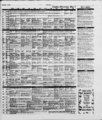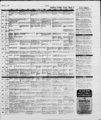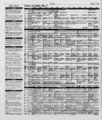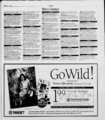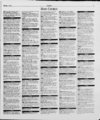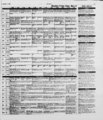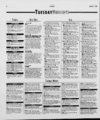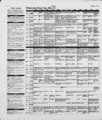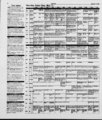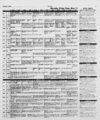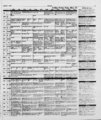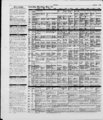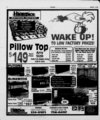| OCR Text |
Show J FAMILIES EDITOR: TAWNY ARCHIBALD t A9 THE DAILY HERALD (www.HarkTheHerdld.com) 344-254- 3 JZZLE FIZC m 4 m m .. rtr j MAY 6, 2000 SATURDAY, sjs tS f Vv V X f II I Paul Tripp ' V '' , Frontier life mixture of love, hope '' i ' .V- ''W'Wl!!' ' Nv.'u.W'?N" legacy1 in!dl7s f - Q r, 'V!- - ... ) if -- min-ute- pot-luc- k - great-grandfath- . great-grandparent- s, great-grandfathe- r, Chapel rooted in history By KAREN HOAG el The Daily Herald The first LELAND chapel of the Leland Ward from was a half mile south of the sugar factory and a quarter mile west of 1908-194- 1 - Leland Milk-- The yard around the light brick three-storbuilding was dirt and y weeds, no lawn. water-whee- at at paultrippairswitch.net. l !: v' As Leland LDS LELAND t:'" Ward celebrates its centennial, pur? Glen R. And Genevieve E. ' Larsen reminisce. Compilers of "Leland's Legacy," the couple was assigned to gather oral and written histories from early settlers still living and to record their histories into a permanent i i ' s book. "It took us 15 months to put the book together," Genevieve i says. "I don't know why people don't research their history more because it's so interest ing." The Larsens interviewed lots of people; accessed history from Stephen Markham Camp of Daughters of Utah Pioneers, the s American Legion records, from LDS History Archives KKMN LKK.'lhc Daily and received photos from gener- Dig In: Hundreds of residents line up for a dinner at the Leland Ward Centennial Celebration on April ous people. 29. The Larsens organized the celebration for the ward into the lives, indusInsight try, school and church events of early pioneers was the Larsens' was also used to sweeten and huh?" money to come to Utah." ;'.;;). goal in their research. in Salt flavor foods. When arrived are Larsens August hardworking. A favorite story Glen likes to sent Lake tired Glen remembers being City, Brigham Young August married two other tell concerns his settlePork him to the all after wives, Spanish Bergitta and Sarah. day long hauling hay Lars Larsen, who along Bertha' with his humble beginEven P. married ment. Larsen. William with his dad, August with wife, Johanna, converted built up a large estate; he took the Olsen the But at William peered Person; nings, wedding sky in Denmark and traveled on the took up half a city mother's the widowed in her a "The sun's and buildings place said, up long first transcontinental train to of a huge hay block, for time another time consisting there's dugout. 1869. in Utah stock corn crib, consist"The dinner barn, sheds, load' wedding Lars Larsen took his little cure smoke house of with beans boiled (to ed hams), Larsen Lars The vinegar original son Lars Peter Larsen with him chicken coop plus a big Glen and coarse to but bread," Utah came train granary, says. by he when went one morning Awhile after the couple margarden. Glen's other plowing in the fields. Playing Still intact, August's house is to asked were Bowens the the ried, help Nelsons, they next to the irrigation ditch, Lars across from Rees Elementary River area colonize the Muddy and Swensons came by covered Peter falls in and yelK "Daddy, School in Spanish Fork. The where Nevada in southern handcart. wagon or come get me; I fell in and can't carried the Swenson-namis After now. His maternal Nevada, property Moapa, get out." for more than 100 years. to two years they returned His dad calls back, "Cling on August Swenson, drove a 'The Fork. goes someone story of team oxen across the plains Spanish to the willows while I go anothhow he was able asked five of took August for another pounds I'll and come Glen; "They round er family, says get such a large estate," build to up sugar in a cotton sack with you while the horses are having August was 20 and traveling by Glen left them when says. himself. a rest." they Spanish Glen laughs as he tells the August answered, "I always Fork," Glen says. "And they "August is Swedish but he like to have something to sell brought two pounds back two story at the Leland Centennial joined the church in Denmark real was a celebration last Saturday, and later at age 16," he says. "He had to sugar years See LELAND, A 0 work four years to earn enough luxury." He adds that molasses says, "Sounds like a Larsen, g Tripp ' J ". V"' The Daily Herald . ancestryfinders.com or yf' i By KAREN HOAG water-powere- d Paul L. Tripp writes life stories, does genealogy research. Contact . OoypDe compiDes years. Olive and the children joined him in 1803. Hope gfeamed bright: New land and new oppor- - 7" tunities beckoned. New communities were foundmills. ed upon Just as flour mills were essential for life's staff, bread, so also saw mills were essential for lumber, of new settlethe building-stuf- f ments. Jonathan's 1820 sawmill would be situated along a creek in Junius, the large wheel driven by water power. Jonathan would have looked for a site where the creek elevation dropped. There Jonathan built a water wheel of wood that diverted water to run over the wheel's pockets, causing it to turn. Jonathan mounted the wheel on a wooden axle, the axle supported by wooden beams, lubricated by animal lard. Adjacent to the wheel Jonathan .built the small building where inside lumber was sawn. The water-whee- l turned the axle, which through a series of cogged wheels transferred the power to a rotating cir- house. Olive and Calvin waited outside. They found father Jonathan's l body. They reversed the a bit, disengaged it, and reverently removed his body from the cogs of the saw. mill. Hope and love, often fueled by tragedy, became the glue of the family and community in the 1800s. It continues so today. . JASt)N OLSON The Daily Herald Olive and Jonathan had settled into Junius, in Seneca County, New York. Jonathan pioneered in 1801. He gathered 500 acres of land within a couple Jonathan's death instant. Reacting to Benajah's shouting account, Olive steadily gathered together her older sons Thomas, married and 27, Charles, 25, and walked with Benajah the short mile or so to the sawmill. Calvin, a son aged 10,Jagged along, terrified at the loss of his father. The older sons entered the mill .'. J Working hard: Glen Larsen plants a field of corn near his home in Leland. Larsen and his wife, Genevieve, spent 15 months compiling the history of Leland into a book, "Leland's Legacy." Larsen's ancestors lived and worked on the same land he owns today. The obituary, from the Geneva Gazette, November 15, 1820, reads:""Mr. Jonathon Tripp, a respectable inhabitant of Junius, aged 59 was killed on the 3rd, in his own sawmill, by being caught in some part of the machinery while attempting some repairs. He was not discovered by his afflicted family until the next power-transfe- I '..jfl my cousin, Charlie Quick, in May 1989. r When one of the cogged wheels failed, it was standard to disengage the mill wheel while fixing it. Jonathan followed this safety precaution. But, when the repair was complete, he had to engage the wheel to test the repair. It would be in this moment that Jonathan likely leaned into the works to check its operation. At age 59, working at night as he was, and with age catching up to his arthritic joints, he faltered, lost his balance and fell head-loninto the power cogs of the mill. His body jammed the works, the water-whestopped, with , 8-- utes ago." I write this story, adding plausible details, of the death of Jonathan Tripp, my third great grandfather. I base it upon his land records and a county history, but mostly his obituary, found by cular saw. V 'X Benajah Tripp screamed all the way home. He found his father, Jonathan, 59, dead in the works of his sawmill. It was November 4, 1820. Benajah, 23, screamed the scene to his mother, Olive. "Father is dead in the mill works. I found his body, just min- i ' Janice Larsen Creer, 72, described this building in a sacrament meeting talk in 1992 in the Leland WardThe at age . book "Leland's Legacy," compiled by Glen and Genevieve Larsen, has recorded her talk. Janice said the wood and coal burning stove was maroon colored and had the brand name "Heatrola." "There were no actual classrooms," she said of the chapel, "so classes were taught in various areas of the building " Some were held in the back of the chapel, another in a corner, still others on the stand, stage, vestry and base- Tnentr One small room near the stage was where food was prepared. "There were no cupboards, so they had to put wooden planks on saw horses to make a table," Janice said. "Everything served and used had to be carried in like dishes, silverware, food and water." Of course the building had no plumbing. A small wooden building, feet northabout west of the chapel, was the restroom (outhouse). 20-3- 0 Parties and dances were held in the basement for the young and she noted, and added, "Dance "floor wax would be sprinkled on the floor to make it slick for dances." Road shows with music and drama and were also enjoyed in the basement, ljelana ward had its own dance band that played for many dif- ferent ward dances in the late '30s and early '40s. In 1938 Leland Elementary School was retired from use, so the Leland Ward got permis. sion from the church building committee to buy and remodel the school for a bigger ward building. They purchased the school in 1939 for JASON OLSON The Daily Herald True teamwork:" Genevieve and Glen Larsen wrote a historical book of Leland. They researched ancestral files and interviewed many people to complete this project. $400; the total cost for remodeling was $25,000. The "new" chapel was dedicated June 27, 1943. Serving well for 35 years, the white stucco chapel was larger and had plumbing and kitchen facilities; a negative aspect was the recre ation hall was too small and the ceiling too low for athletic use. The last sacrament meeting was held there Aug. 3, 1977. The Leland Ward is still intact. "Leland's still close to Sec CHAPEL, A 10 |
















































